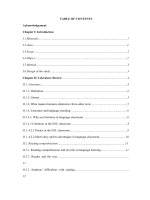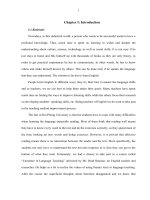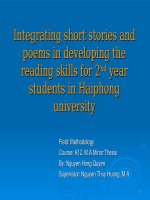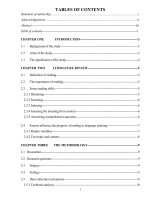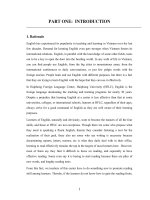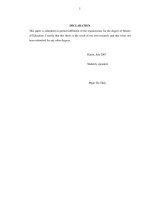Improve students’ reading skills
Bạn đang xem bản rút gọn của tài liệu. Xem và tải ngay bản đầy đủ của tài liệu tại đây (285.99 KB, 51 trang )
TABLES OF CONTENTS
Statement of authorship...............................................................................................................i
Acknowledgements.....................................................................................................................ii
Abstract-----------------------------------------------------------------------------------------------------iii
Table of contents-----------------------------------------------------------------------------------------1
CHAPTER ONE INTRODUCTION-------------------------------------------------------3
1.1 Background of the study-------------------------------------------------------------------------3
1.2 Aims of the study---------------------------------------------------------------------------------3
1.3 The significance of the study--------------------------------------------------------------------4
CHAPTER TWO LITERATURE REVIEW------------------------------------------------5
2.1 Definition of reading-----------------------------------------------------------------------------5
2.2 The importance of reading-----------------------------------------------------------------------5
2.3 Some reading skills-------------------------------------------------------------------------------5
2.3.1 Skimming-----------------------------------------------------------------------------------------5
2.3.2 Scanning------------------------------------------------------------------------------------------6
2.3.3 Inferring-------------------------------------------------------------------------------------------6
2.3.4 Guessing the meaning from context-----------------------------------------------------------6
2.3.5 Answering comprehension question----------------------------------------------------------6
2.4 Factors influence the progress of reading in language learning-----------------------------7
2.4.1 Reader variables---------------------------------------------------------------------------------7
2.4.2 Text topic and content---------------------------------------------------------------------------8
CHAPTER THREE THE METHODOLOGY------------------------------------------------9
3.1 Researcher-------------------------------------------------------------------------------------------9
3.2 Research questions----------------------------------------------------------------------------------9
3.3 Subject---------------------------------------------------------------------------------------------9
3.4 Setting----------------------------------------------------------------------------------------------9
3.5 Data collection instruments----------------------------------------------------------------------9
3.5.1 Textbook analysis------------------------------------------------------------------------------10
1
3.5.2 Questionnaire-----------------------------------------------------------------------------------10
3.5.3 Observation-------------------------------------------------------------------------------------12
3.6 Data collection procedure----------------------------------------------------------------------13
3.6.1 Textbook analysis procedure-----------------------------------------------------------------13
3.6.2 Questionnaires procedure---------------------------------------------------------------------13
3.6.3 Observation procedure-------------------------------------------------------------------------13
CHAPTER FOUR RESULTS AND DISCUSSIONS-----------------------------------------14
4.1 Results--------------------------------------------------------------------------------------------14
4.1.1 Results of textbook analysis------------------------------------------------------------------14
4.1.2 Results of questionnaires----------------------------------------------------------------------19
4.1.3 Results of observation-------------------------------------------------------------------------35
4.2 Discussions---------------------------------------------------------------------------------------40
4.2.1 Research question (1)--------------------------------------------------------------------------40
4.2.2 Research question (2)--------------------------------------------------------------------------41
CHAPTER FIVE CONCLUSIONS AND RECOMMENDATIONS-------------42
5.1 Conclusions--------------------------------------------------------------------------------------42
5.2 Recommendations-------------------------------------------------------------------------------42
5.2.1 For the textbook--------------------------------------------------------------------------------42
5.2.2 For teachers-------------------------------------------------------------------------------------43
5.2.3 For students---------------------------------------------44Error: Reference source not found
5.3 Limitations of the study------------------------------------------------------------------------49
REFERENCES-------------------------------------------------------------------------------------------51
APPENDIXES--------------------------------------------------------------------------------------------52
Appendix 1a----------------------------------------------------------------------------------------------52
Appendix 1b----------------------------------------------------------------------------------------------55
Appendix 2-----------------------------------------------------------------------------------------------58
Appendix 3-----------------------------------------------------------------------------------------------62
2
CHAPTER ONE INTRODUCTION
1.1 Background of the study
English is one of the important subjects at High School. It has been used for Final
Examinations to evaluate students’ level of knowledge. Therefore, whether students are
proficient at English or not is very important to them.
Being proficient at English means student is good at both received skills - reading and
listening, and productive skills - speaking and writing. These four skills are integrated in a
lesson to improve all these skills for the students, because one certain skill can be used to
improve the others.
Reading is an important and useful skill, because reading is the first step for students to
get main and general information about a topic and it is a tool for students to get more
information. In addition to, through reading, students can improve their vocabulary in various
fields such as real life, science, and culture. Reading can not only train students’ thinking
abilities but it also gives students a lot of updated information. In real life, students are able to
read different kinds of materials such as documents, newspapers, and magazines. Therefore,
reading is one of the good ways to get information, and to obtain knowledge.
Reading is an important skill and subject, while “Most of grade 10 students in Thanh
Binh-1 High School are not very good at Reading.” said, Mr. NguyenVan Be No, the Head of
Foreign Language Teaching Staff in Thanh Binh-1 High School.
As a student of pedagogical field, and a teacher of English in the near future, I am
concerned in this problem. Moreover, no one has studied the causes of the problem so far. For
some reasons above, the study was carried out to seek the real reasons, as well as, the solutions
to the problems.
1.2 Aims of the study
- To find out grade 10 students’ common problems in learning reading
- To suggest solutions for these problems
3
1.3 The significance of the study
Via solutions suggested in the study that based on the real problems also found in the
study, both teachers of English and students to solve the problems in reading classes. The
teachers can get certain suggestions to teach English reading more successfully or improve
students’ reading skills because being good at reading partly helps students good at learning
EFL. It means the study can partly help teachers and students better their teaching and
learning.
4
CHAPTER TWO LITERATURE REVIEW
2.1 Definition of reading
Reading comprehension does not mean being able to answer all questions in the tasks
in the textbook
Reading comprehension is understanding a text that is read, or the process of
"constructing meaning" from a text. Comprehension is a "construction process" because it
involves all of the elements of the reading process working together as a text is read to create a
representation of the text in the reader's mind. (As defined by Partnership for Reading (2005))
Mr. Françoise Grellet (1992) defines that understanding a written text means extracting
the required information from it as efficiently as possible.
2.2 The importance of reading
In the first place, many of people want to be able to read texts in English for their either
study purposes or simple for pleasure. All we can do to make reading easier are significant.
Reading texts also provide good models for English writing. When we teach the skill of
writing, we will need to show students models of what we are encourage them to do.
Reading texts also provide opportunities to study language such as vocabulary,
grammar, pronunciation and the way we construct sentences, paragraphs and texts.
Lastly, good reading texts can introduce interesting topics, stimulate discussion, excite
imaginative responses, and be fascinating lessons.
2.3 Some reading skills
2.3.1 Skimming
According to Wegmann, B. and Knezevic, M. (2007), skimming is a useful way to get
an overview of a reading section. To skim, move your eyes quickly through the whole reading;
make sure that you look at the titles, headings, and illustrations. Do not stop for details or
worry about words you do not understand. Keep going like a fast-moving train from beginning
to end. Afterward, you will have a general idea of the content. Then you can read the text
again with better comprehension.
5
2.3.2 Scanning
According to Wegmann, B. and Knezevic, M. (2007), we skim for general ideas, for
facts or details. To scan, move the eyes quickly over the reading until we come to the specific
piece of information that we want. If you know that it is in the middle or toward the end of the
reading, start there. Do not be distracted by other items. Concentrate. When we find what we
want, use it. Then go to the next point.
2.3.3 Inferring
According to Wegmann, B. and Knezevic, M. (2007), inferences are ideas or opinions
are not stated but that can be inferred from the information given. For example, if your friend
says, “Shoot! I have to wear my heavy coat today,” you can infer that he thinks it is cold
outside and that he is not happy about this. Learning how to make inferences makes you a
better reader and a clearer thinker.
2.3.4 Guessing the meaning from context
As mentioned by Forseth, R et all (1998), this skill should be develop as a normal
response to unknown words in a passage to avoid an excessive use of the dictionary.
2.3.5 Answering comprehension question
While reading, the students are asked to answer some questions about the passage. In
other words, they perform how well they obtain knowledge through answering these
questions, using their skills in reading.
6
2.4 Factors influence the progress of reading in language
learning
2.4.1 Reader variables
2.4.1.1 Background knowledge
The nature of the knowledge that the readers have will influence not only what they
remember of the text, but the product – their understanding of the text – and the way they
process it. What they know affects what they understand.
2.4.1.2 Knowledge of language
According to Alderson, J.C. (2003), if readers do not know the language of the text,
then they will have great difficulties in processing the text. Nevertheless, structure knowledge
has been shown to have a facilitative effect on reading.
Having to struggle with reading because of unknown words will obviously affect
comprehension and will take the pleasure out of reading. Alderson, J.C. (2003) cited from
Research by Laufer (1989), Liu, and Nation (1985) that readers need to know 95% of the
words in the text to gain adequate comprehension and to be able to guess unknown words
from the text.
On the other hand, not very surprisingly, in second- and foreign-language reading
studies, there was an early emphasis on the importance of syntactic as well as lexical
knowledge.
In second-and foreign-language reading, it has always been assumed that learners must
first acquire language knowledge before they can read.
Alderson, J.C. (2003) showed that students had difficulty identifying the constituent
structures in sentences with complex or unusual syntax. For example, where material preposed
before the main verb or adverbial phrases come before the main clause. The ability to parse
sentences into their correct syntactic structure appears to be an important element in
understanding text. Moreover, students found it harder to process syntactic structures in
English that differed from structures in the mother tongue.
7
2.4.1.3 Knowledge of topic
Knowing how texts are organized – what sort of information to expect in what place –
as well as knowing how information is signaled, and how changes of content might be marked
– has long been thought to be of importance in facilitating reading. For example, knowing
where to look for the main ideas in the paragraph, and being able to identify how subsidiary
ideas are marked, ought in principle to help a reader to process information.
2.4.1.4 Reader motivation/interest
Studies of poor second-language readers have shown that poor readers lack of
motivation to read or spend time improving their ability to read. Of course, this is as likely to
be effect of poor reading as the cause of it, but once established, poor motivation doubtless
compounds the problem (‘success breeds success, failure breeds failure’).
2.4.2 Text topic and content
The other side of the coin in the reader-text interaction is the text itself. Many aspects
of text that might facilitate or make difficult the reading process have been studied, from a
variety of different disciplines. Although linguistic is the obvious major source of insight into
the language of text, texts have often been studied from a linguistic perspective without
concern for the reader. It has too often been assumed that the analyst represents a typical
reader, and that what results from the analysis can therefore be assumed to be true of any
language processor.
However, some linguists and particularly applied linguists have indeed been concerned
with the impact of linguistic variables on the process of understanding texts.
8
CHAPTER THREE THE METHODOLOGY
3.1 Researcher
The researcher of the study is a fourth year student of Foreign Language Department,
Dong Thap University.
3.2 Research questions
The thesis attempts to answer the following questions:
(1) What are grade 10 students’ problems in learning reading?
(2) What are the solutions for these problems?
3.3 Subject
Students at grade 10 in Thanh Binh-1 High School, they have been learning English for
more than three years.
Teachers who have been teaching English for a long tine in Thanh Binh-1 High School
are experienced teachers.
English 10 textbook were analyzed to find out whether it contained problems.
3.4 Setting
The survey took place in Thanh Binh-1 High School where the researcher carried out
teaching English performance.
It was done in co-operation with the teachers and the students from February to March
2009.
3.5 Data collection instruments
A number of procedures have been used for collecting information such as interviews,
observations, record reviews, diaries, material analysis, etc. In this research, three instruments:
textbook analysis, questionnaires and observation were chosen and employed. The usage of
these instruments will be discussed below:
9
3.5.1 Textbook analysis
The textbook are a material of reading; therefore, some of reading lessons in the
textbook English 10, which would be taught or observed during the researcher’s teaching
performance and contained problems, was analyzed to find out some common problems from
them.
3.5.2 Questionnaire
A questionnaire is “an instrument for the collecting data, usually in written form,
consisting of open and /or closed questions and other probes requiring a response from
subjects.” (Ms. Le Hong Phuong Thao. M.A. cited from Nunan (1992, p.231)).
Questionnaires are printed form for data collection, which includes questions or
statements to which the subjects are expected to respond, often anomalously. (Ms. Ms. Le
Hong Phuong Thao, M.A. cited from LevSalinger & Shohamy (1989, p. 172))
Many researchers state that questionnaires are commonly used to collect data on
phenomena, which are not easily observed, such as attitudes, motivation and self-conceptions,
in other words, those in social science.
The present researcher’s choice of using questionnaires comes from the following
reasons. Firstly, questionnaires save the researcher’s time. They are self-administered and can
be given to large groups at the same time (Salinger & Shohamy, 1989). It is easy to get the
information from many people quickly and without the need of the researcher’s presence.
Secondly, questionnaires help avoid pressure of interview bias when completing the
questionnaires. Furthermore, when anonymity is assured, respondents tend to feel free to what
they answer so that the result will be objective. It is because there is no face-to-face interaction
between subjects and the interviewer. Questionnaires in the form of closed questions or
statements, in which the respondent is asked to select an answer from a list provided by the
researcher, provide a great uniformity and standard of responses are easy for statistical
analysis afterwards.
In order to answer the research questions, the two questionnaires were used:
- Questionnaire 1a- for students (See Appendix 1a-in English, Appendix 1b-in
Vietnamese) was given to the students. The questionnaire was firstly designed in English.
Then - during the study in Thanh Binh-1 High School, the Questionnaire 1b was designed to
10
find out the problems, it was translated into Vietnamese for the students to answer more easily
and correctly. It is designed for the two main purposes as following:
* To seek information about the students’ opinion about a Reading lesson in
class
* To find out the students’ common problems in reading
The questionnaire designed includes 20 questions. 204 copies of the questionnaire in
Vietnamese were given to the students in class, and collected all of them after 15 minutes.
Question (1) was used to find out whether the students have habits in reading.
From question (2) to the question (4) were employed to know about the students’
interest in reading.
Question (5) and question (6) were implemented to get information about the students’
preparation vocabulary for reading.
Question (7) and question (8) were designed to get information about the students’
memory in learning vocabulary.
Question (9) was used to know whether the teachers employed techniques to elicit
vocabulary.
From question (10) to the question (14) were applied to know how well students’
reading skill was.
Question (15) and question (16) were implemented to look for the reasons why students
are not very good at reading.
From question (17) to question (18) were used to seek information about the students’
dealing with the tasks.
It is very common that students have often used reference books to do the tasks
mentioned in the textbooks. Therefore, question from (19) to (20) were designed to find out
the truth of this problems.
- Questionnaire 2-for teachers: (See Appendix 2)
* To seek information about their common techniques in a Reading lesson
* To find out their difficulties in a Reading lesson
Ten copies of the questionnaire were given to ten teachers at the beginning of my
practice teaching course in Thanh Binh-1 High School and collected after a week.
Question (1) and question (2) were designed to know about teaching vocabulary in
reading classes.
11
Question (3) was applied to find out whether the amount of vocabulary taught is
enough or not for the students.
Question (4) was employed to know how often the teachers elicit the words in pre-
teaching vocabulary.
Question (5) was used to know whether the teachers could make the stages of reading
class relate to the others.
Question (6) question (7) question (8) were implemented to know the teachers’ ability
in making reading more interesting.
Question (9) to question (12) were designed to know if the teachers redesigned the
tasks in the textbook.
Question (13) was used to know if the teachers integrate the skills in reading lessons.
Question (14) was applied to find out the reasons why the students were not
very good at reading.
Question (15) was employed to know the difficulties of the teachers in teaching
reading.
Question (16) was used to seek the teachers’ solutions to the problems in reading
lessons.
Question (17) was designed to seek the teachers’ solutions to improve the students’
reading skill.
3.5.3 Observation (See Appendix 3)
Based on problems found out from the textbook, observation was applied to know how
both the teachers dealt with them.
To do this job, some criteria was employed such as eliciting vocabulary, designing the
tasks, changing the tasks’ orders, using reading activities, making the tasks proper with the
students’ level, etc.
3.6 Data collection procedure
3.6.1 Textbook analysis procedure
Before the researchers’ teaching performance in Thanh Binh-1 High School, she had
chosen some reading lessons in textbook English 10 that were taught or observed during the
12
study. Moreover, only reading lessons containing problems, according to the researcher, were
analyzed, because it would be more accurate to use both analysis and observation.
To seek the textbook’s problems easily and quickly, some aspects of the reading
lessons were selected and analyzed such as shape of the lesson, the tasks’ requirements, and
the tasks’ orders. The details are mentioned in chapter four.
3.6.2 Questionnaires procedure
204 the same copies of the questionnaire designed in Vietnamese were given to 5
classes of grade 10 in Thanh Binh-1 High School from February 16
th,
2009 to February 21
st
,
2009 in class and collected after 15 minutes. However, there were 197 acceptable ones were
analyzed.
3.6.3 Observation procedure
During the time of teaching performance in the school, the researcher was going to
participate in reading classes of grade 10 students and observe how well the students and the
teacher performed in teaching and learning reading.
The researcher chose some certain criteria to help her find out how the teachers dealt
with the problems that the researcher found in the textbook such as redesigning the textbook.
Via observation and teaching, the common problems in reading classes were taken note
and then analyzed to find out students’ common problems in reading and the real causes of
these problems. Thanks to the causes, some solutions to the problems were suggested.
13
CHAPTER FOUR RESULTS AND DISCUSSIONS
Chapter three has mentioned the three data collection instruments – questionnaires,
observation and material analyzing. Therefore, this chapter will go on with the information
collected from the three above instruments and discus the results of the study in detail.
4.1 Results
This section will report the results of data analysis; it includes three main parts such as
results of textbook analysis, questionnaires analysis and observation analysis.
4.1.1 Results of textbook analysis
Before the researcher’s teaching performance in Thanh Binh-1 High School, she
analyzed some reading lessons in the textbook English 10, which were observed or taught
during the study. The results via analyzing them are showed below.
14
Unit 10: CONSERVATION
Lesson A: Reading (English 10, p.104-p.106)
Shape of the lesson Activities/Tasks Comments
“Before you read”
Look at the pictures and then
answer the questions.
- The task is for introducing the
topic, the new lesson, not for
pre-reading.
- Use task 2 as pre-reading
activity.
“While you read”
- Task 1: Match the word in
A with a suitable definition
in B.
- Task 2: Decide whether the
following statements are true
(T) or false (F).
- Task 3: Choose the most
suitable main idea for each
paragraph
- The orders of the tasks are not
suitable.
- Change the orders: task 1, task
3 and task 4.
“After you read”
- Task 4: Answer the
following questions.
- Change the task: Talk about the
role of the environment, using
the given cues.
15
Unit 12: MUSIC
Lesson A: Reading (English 10, p. 124-p.126)
Shape of the lesson Activities/Tasks Comments
“Before you read”
Work in pair. Discuss and
match each of the
descriptions to a type of
music.
- The task is for introducing the
topic, the new lesson, not for
pre-reading.
- Add pre-reading activity: pre-
reading activity.
“While you read”
- Task 1: The words /
phrases in the box below all
appear in the reading
passage. Use them to
complete the sentences.
- Task 2: Answer the
questions.
-The tasks are in correct orders.
- Add the questions of task 3 to
task 2.
“After you read”
- Task 3: Work in pairs. Ask
and answer the questions
below.
- The task is the same as task 2.
It is quite simple and boring.
-Change the task: Talk about the
role of music in your lives.
16
Unit 13: FILMS AND CINEMA
Lesson A: Reading (English 10, p. 132-p.134)
Shape of the lesson Activities/Tasks Comments
“Before you read”
Work with a partner. Answer
the questions.
- The task is for introducing the
topic, the new lesson, not for
pre-reading.
- Add pre-reading activity such
as true/false statements
prediction, or predict what the
text will say.
“While you read”
- Task 1: Find the word in
the passage that can match
with the definition on the
right column.
Task 2: Work in pairs.
Answer these questions.
- Task 3: Decide which of
the options below is the best
title for the passage.
- The orders of the tasks are not
proper.
- Change the orders of the tasks:
task 1, task 3, and task 2.
“After you read”
- Task 4: Work in groups.
Talk about the passage, using
the cues bellow.
- The task is suitable.
17
UNIT 14: THE WORLD CUP
Lesson A: Reading (English 10, p. 142-p.144)
Shape of the lesson Activities/Tasks Comments
“Before you read”
Work with a partner. Answer
the following questions.
- The task can be used for pre-
reading. However, it is better to
add more questions.
“While you read”
- Task 1: The words in A
appear in the reading
passage. Match them with
their definitions in B.
- Task 2: Scan the text and
complete each of the
following sentences with a
word or a number.
- Task 3: Read the text again
and decide whether the
following statements are true
(T) or false (F). Correct the
false ones.
- The orders of the tasks are not
proper.
- Use task 3 as pre-reading
activity.
- Maybe, add some questions as
Task 4: Answer questions.
“After you read”
- Task 4: Work in groups.
Talk about the events
mentioned in the passage,
using the following figures as
cues.
- The task is proper.
18
Unit 15: CITIES
Lesson A: Reading (English 10, p. 156 – p. 158)
Shape of the lesson Activities/Tasks Comments
“Before you read”
- Work in pairs. Below are
some well-known places in
New York. Match the names
to the pictures.
- Answer the questions.
- The task is for introducing the
topic, the new lesson, not for
pre-reading.
- Use task 2 for pre-reading
activity.
“While you read”
- Task 1: The words in A
appear in the reading text.
Match them with their
definition in B.
- Task 2: Decide the
whether the statements are
true (T) or false (F).
- Task 3: Answer the
questions.
- The orders are not proper.
-Change the orders: Task 2, task
1, and task 3.
“After you read”
- Task 4: Work in groups. If
you could visit New York,
which place(s) of interest
there would you like to see?
Why?
- The task is not easy for the
student do well because New
York is not familiar to the
students.
- Change the task: Talk about a
city in Vietnam that you want to
visit.
19
Via analyzing some Reading lessons of the textbook English 10, something wrong was
found as following:
- The shape of the reading lessons often has no pre-reading activity.
- The suggested activities are not very plentiful.
- The orders of the tasks are not very proper.
- Some tasks are over students’ ability.
4.1.2 Results of questionnaires
4.1.2.1 Questionnaire for students
Table 4.1.1 The students’ habit of reading
Question 1 Every day Once to twice Never
Other ideas
C
1
%
2
C % C % C %
After class, how
often do you
read a week?
41 20.8 63 32.0 93 47.2 0 0
The number of the students who read everyday is much less than the others who rarely
read. It is the fact that a large amount of the student (79.2%) has no habit in reading.
Table 4.1.2.a The students’ interest in reading
Question 2 Yes No
C % C %
Do you like reading? 151 76.6 46 23.4
The answers to the questions reveal that the number of students who like reading is
more than those who do not like reading three times. It means the students may still like
reading.
1
Notes:
count / number of responses
2
percent
20
Table 4.1.2.b The students’ interest in reading
Question 3
The content is
poor
The topic is
useful
The topic is not
interesting
Other ideas
- The text is
good
- The topics are
new
C % C % C % C %
When you read,
you feel…
29 14.7 37 18.8 46 23.4 105 53.3
More than half of the students support the content and the topics of reading text in the
textbook. However, the others (38.1%) do not agree, they maybe want the text to be changed.
Table 4.1.2.c The students’ interest in reading
Question 4 Difficult Easy Very difficult Very easy
C % C % C % C %
In your opinion,
learning reading
is…
91 46.2 21 10.7 28 14.2 57 28.9
Over half of the students feel reading is difficult, and a few of them (39.6%) feel
reading is not difficult. This may be the problems of reading classes because the negative
feelings can prevent the students from reading.
Table 4.1.3.a The students’ preparation vocabulary for reading
Question 5
Every reading
lesson
Sometimes Never Other ideas
C % C % C % C %
How often do
you prepare new
words for reading
lessons?
49 24.9 52 26.4 96 48.7 0 0
The table shows that 26.4% of the students “sometimes” prepare vocabulary for
reading, and 48.7% of them “never” do. It means 75.1% of them do not prepare well and
24.9% of them do well. After all, there is no doubt that the students do not prepare for their
reading lessons may be one of the problems in reading.
21
Table 4.1.3.b The students’ preparation vocabulary for reading
Question 6
Every day Sometimes Never Other ideas
C % C % C % C %
How often do
you learn new
words at home?
84 42.6 87 44.2 26 13,2 0 0
The table also reflects there are less than half of the students (42.6%) learn the
vocabulary “everyday”. It means many the students do not learn the vocabulary at home. This
problem can make the students lack vocabulary for better reading.
Table 4.1.4.a The students’ memory in learning vocabulary
Question 7
More than
70%
50% - 70% Less than 50% Nothing
C % C % C % C %
How many
percents of new
words you can
learn by heart in
class?
21 10.7 86 43.6 79 40.1 11 5.6
According to the result, there are only 10.7% of the students learn the vocabulary well
in class as soon as the reading class finishes. It is possible to say that most of them are not able
to remember the words quickly.
22
Table 4.1.4.b The students’ memory in learning vocabulary
Question 8
More than
80%
60% - 80% About 50% Less than
50%
Other ideas
C % C % C % C % C %
You can
remember
about … of
the words,
you learn.
12 6,1 7 3.6 86 43.6 92 46.7 0 0
As we have known, the number of the words can be taught is more than 5 and less than
8 words. It is not too much. However, there are only 6.1% of the students are able to
remember the words they learn quite well. It means many students are not able to remember
well.
Via the results of question (7) and question (8), it is possible that the students have no
good memory in learning vocabulary.
Table 4.1.5 The teachers’ using techniques in teaching vocabulary
Question 9
Always Often Sometimes Rarely Other ideas
C % C % C % C % C %
How often
does your
teacher elicit
the words in
reading
lessons?
31 15.7 57 28.9 68 34.6 41 20.8 0 0
Whether the teacher uses techniques to elicit the words is very important, because
images, actions, and explanations can make impression on the students. They help the students
remember the words more easily and better.
However, it is the fact that the teachers do not often use techniques for eliciting
vocabulary. 54.4% of the students admit their teachers “sometimes” or “rarely” teach new
words with techniques.
23
Therefore, it is not doubtful; the teachers do not often use techniques to elicit the words
for their students to guess. This can make the students remember the words difficultly.
Table 4.1.6.a The students’ skills in reading
Question 10
What you have
already known
about the topic
Vocabulary
related to the
topic
Predict what
the text will
give you
Nothing
C % C % C % C %
Before reading,
what do you
think of?
41 20.8 96 48.7 46 23.4 24 12.2
To prepare for reading, the students also have to use proper skills. However, the result
reflects that the students have no skills for pre-reading. Half of them still think very highly of
vocabulary in reading texts and approximately 1/8 of them think nothing about the topic. And
44.2% of the students seem to have skill to prepare for reading.
However, frankly speaking, more than half of the students have no skills for preparing
reading. This is also obstacle of reading.
24
Table 4.1.6.b The students’ skills in reading
Question 11
Read the text
carefully and
try to know the
meaning of all
the words to
understand the
text.
Move your eyes
quickly through
the whole
reading.
See the titles,
the headings,
the
illustrations
and the photos.
Other ideas
C % C % C % C %
If you want to
get the main
idea, you will
137 69.5 47 23.9 13 6.6 0 0
Question 12
Move your
eyes quickly
over the
reading until
you find the
specific piece
of information
that you want.
Read the text
carefully and
try to know the
meaning of all
the words to
understand the
text.
See the titles,
the headlines,
the illustration
and the photos,
and so on.
Other ideas
C % C % C % C %
If you want to
get specific
information, you
will
36 18.3 109 55.3 52 26.4
The students’ answers to the two questions above show that there are not so many
students having skill to get the main idea of the reading text, while, 7/10 of them lack the skill.
There is no doubt that most of the students have no primary skill for reading – skimming.
A large percentage of students do not know how to get the specific information from
the reading text. There are fewer than 19% of the students being able to get the scanning skill.
25
